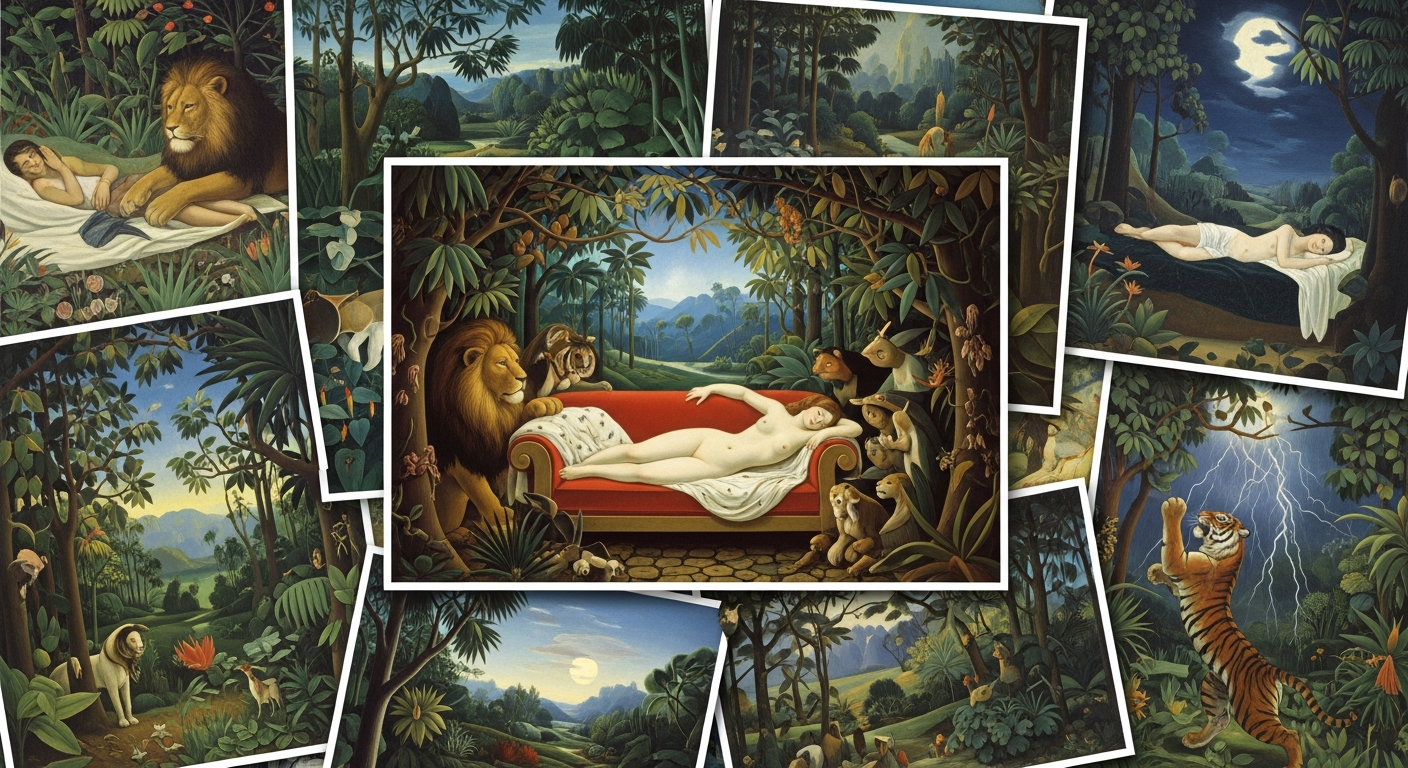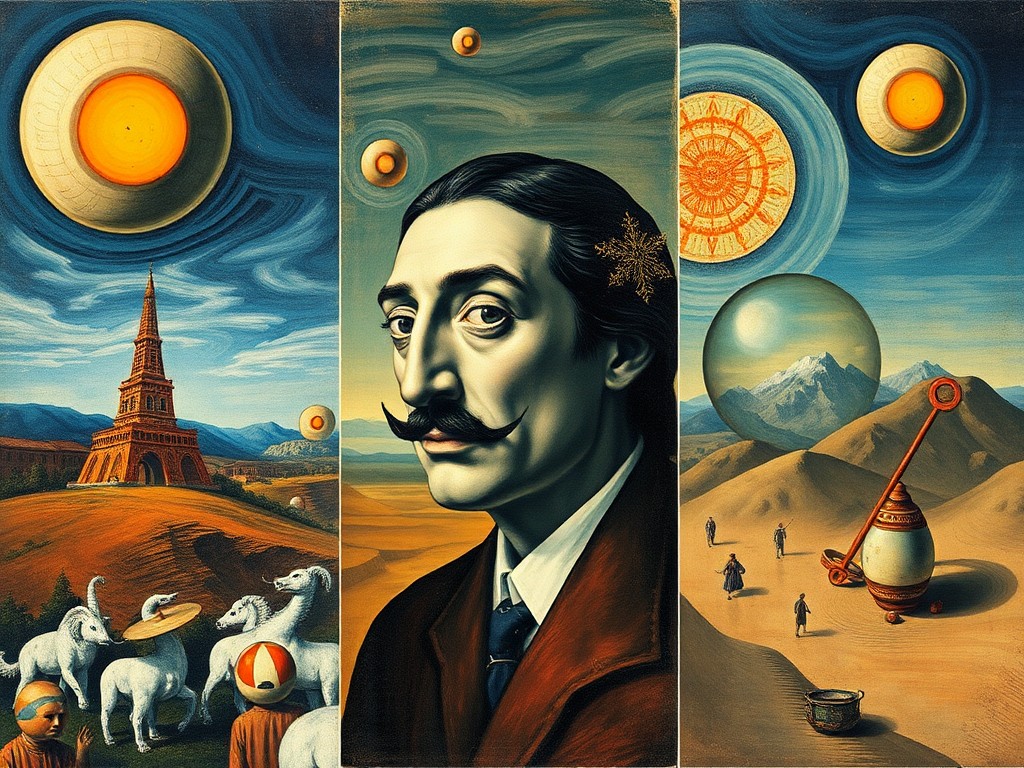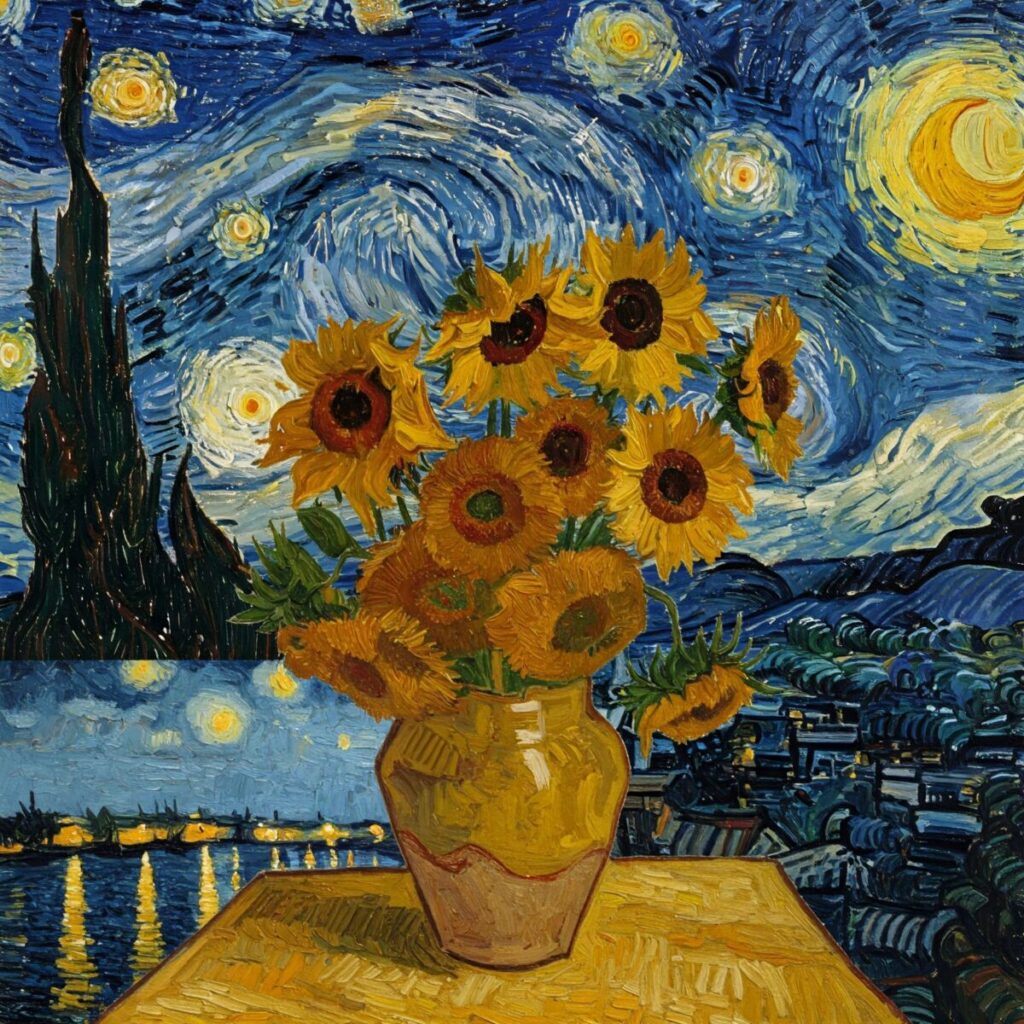Imagine painting lush, wild jungles filled with exotic animals without ever leaving your city. That’s exactly what Henri Rousseau did! A self-taught artist, Rousseau worked as a customs officer in Paris, earning him the nickname ‘Le Douanier.’ While critics at the time often made fun of his unique style, the world eventually came to celebrate the imaginative and dreamlike quality of Henri Rousseau paintings. He wasn’t trained like other famous artists, which is exactly what makes his work so special. He painted from his heart and his imagination, creating a world that was entirely his own. Let’s dive into the vibrant, mysterious, and unforgettable world of the top 10 Henri Rousseau Paintings.
The Sleeping Gypsy (1897)
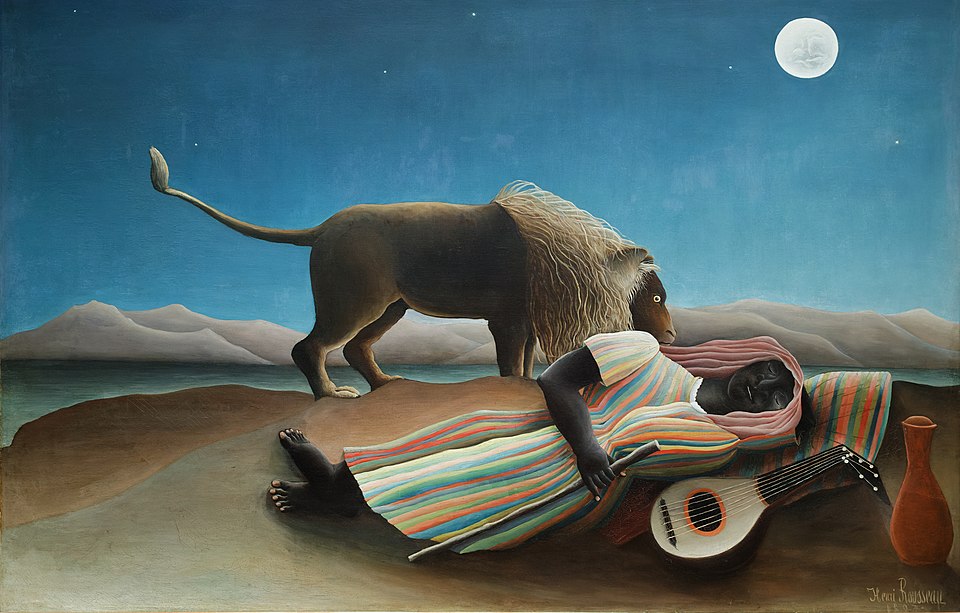
Description: In the quiet of a moonlit desert, a woman sleeps soundly while a curious lion stands over her, seemingly mesmerized. This painting is a perfect example of Rousseau’s dreamlike style. There’s no real danger, just a strange and peaceful mystery. The scene feels like it was plucked directly from a dream, mixing the ordinary with the extraordinary in a way that makes you wonder what story is being told. Rousseau once tried to sell this painting to the mayor of his hometown, describing it as a ‘poetic’ scene, but the offer was rejected.
Painting Techniques: Rousseau used bold, flat areas of color and sharp outlines to create a scene that feels both realistic and fantastical. He paid careful attention to details, like the stripes on the gypsy’s robe and the individual strands of the lion’s mane, using layers of oil paint to achieve a rich, vibrant finish.
Location: Museum of Modern Art (MoMA), New York City, USA
Estimated Value: Priceless
The Dream (1910)
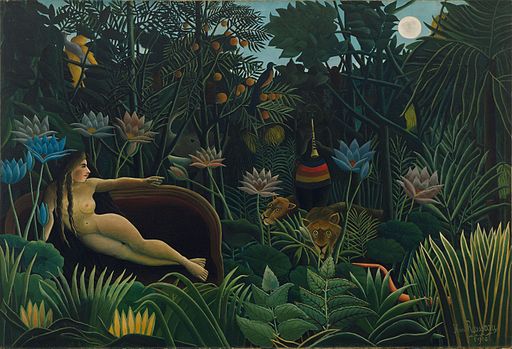
Description: This was Rousseau’s final masterpiece, and it’s a stunner. A nude woman reclines on a fancy sofa right in the middle of a dense, overgrown jungle. Lions, elephants, and exotic birds peek through the massive leaves and flowers. The painting is based on a story the woman, Yadwigha, is telling of a dream she had, blending her living room with a wild, imaginary landscape. It’s one of the most famous Henri Rousseau paintings. To create his famously oversized plants, Rousseau visited the botanical gardens in Paris for inspiration.
Painting Techniques: He employed a technique of layering paint, starting with the sky and working his way to the foreground. The foliage is incredibly detailed, with over 22 different shades of green used to create a sense of lush depth, even though the perspective is intentionally flattened.
Location: Museum of Modern Art (MoMA), New York City, USA
Estimated Value: Priceless
Tiger in a Tropical Storm (Surprised!) (1891)
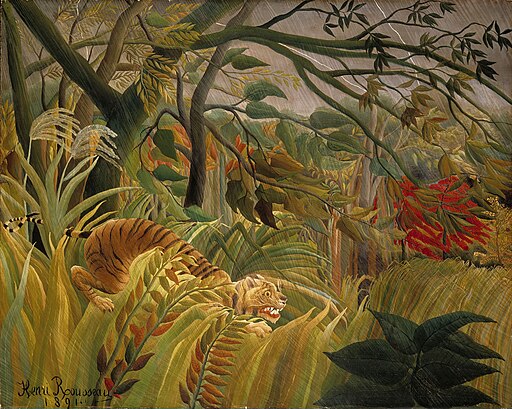
Description: This was the first of Rousseau’s famous jungle scenes. A fierce tiger, teeth bared, is caught in the middle of a raging tropical storm. The wind whips the jungle foliage back and forth, and streaks of rain slash across the canvas. You can almost feel the energy and fear in the scene as the tiger prepares to pounce on its unseen prey. The raw power of nature is the true star here. Despite the exotic setting, Henri Rousseau never actually left France or saw a real jungle in his life.
Painting Techniques: Rousseau created the effect of driving rain by using thin, silvery-white brushstrokes slanted across the entire painting. He built up the jungle with countless shades of green, giving it a dense, almost claustrophobic feel that enhances the storm’s intensity.
Location: The National Gallery, London, UK
Estimated Value: Priceless
The Hungry Lion Throws Itself on the Antelope (1905)
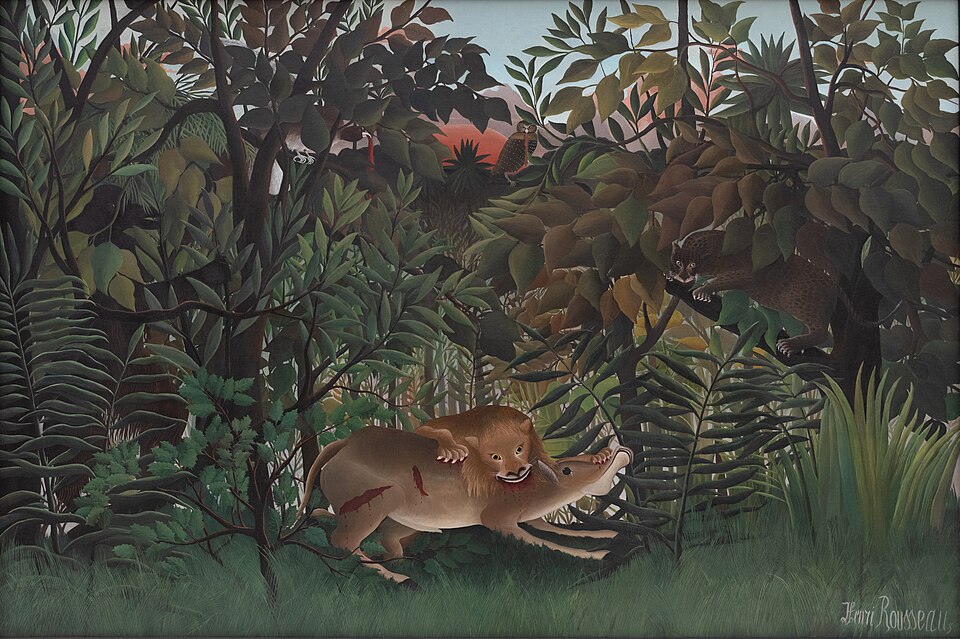
Description: This large and dramatic painting depicts a violent scene where a lion attacks an antelope, while other jungle creatures watch from the dense foliage. An owl, a panther, and a monkey are visible in the background. The raw, primal energy of the scene was shocking to audiences at the time but showcased Rousseau’s powerful imagination and his ability to create a world that was both beautiful and terrifying. This painting was exhibited at the 1905 Salon d’Automne alongside works by artists who would soon be known as the Fauves, like Henri Matisse.
Painting Techniques: Rousseau used a rich, dark palette to create the jungle’s shadowy depths, making the bright red blood of the antelope stand out dramatically. The figures are stylized, with the artist focusing more on the emotional impact of the scene than on perfect anatomical accuracy.
Location: Fondation Beyeler, Riehen, Switzerland
Estimated Value: Priceless
The Snake Charmer (1907)

Description: A mysterious, silhouetted figure stands on a riverbank at dusk, playing a pipe to charm several snakes that emerge from the water and foliage. The scene is bathed in the eerie light of a large, glowing moon. The painting has a hypnotic, magical quality, drawing the viewer into its silent, enchanted world. It feels less like a real place and more like a scene from a forgotten myth or legend. The painting was commissioned by the mother of artist Robert Delaunay, who claimed she heard stories of Rousseau’s travels in Mexico, though he never went.
Painting Techniques: Rousseau’s use of silhouette for the main figure is a powerful choice, adding to the mystery. The dark, almost black, foliage is punctuated by the bright, stylized eyes of jungle animals, creating a feeling of being watched from the shadows.
Location: Musée d’Orsay, Paris, France
Estimated Value: Priceless
Boy on the Rocks (1895-1897)
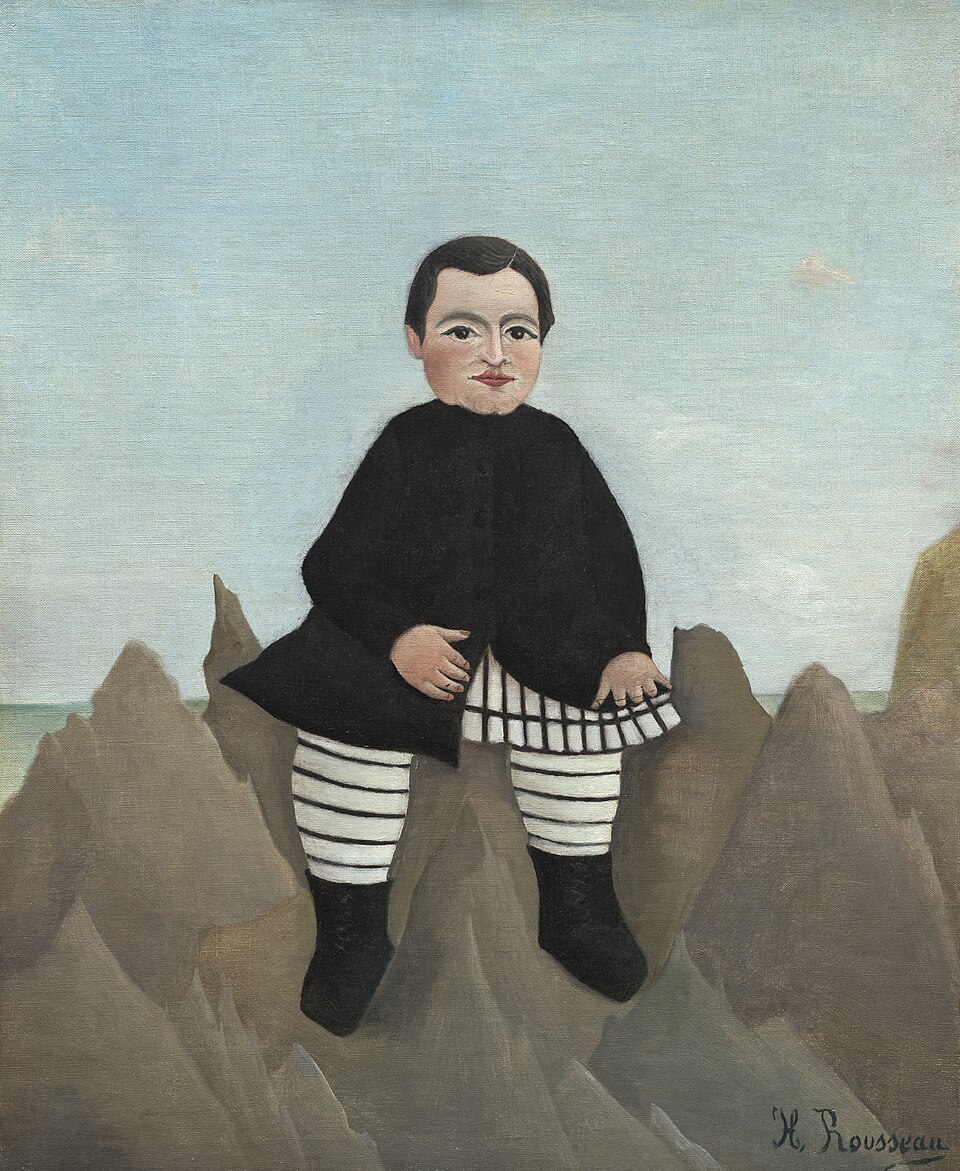
Description: This painting is a bit different from his famous jungles. It shows a young boy with a slightly unsettling, doll-like face sitting on some strangely smooth, rounded rocks. The colors are bright and the composition is simple, but there’s an odd, surreal feeling to it. The boy seems out of place, almost like a toy placed in a landscape, which is a hallmark of Rousseau’s unique and charming style. The boy’s stiff pose and oddly formal clothes contrast sharply with the natural, albeit strange, landscape around him.
Painting Techniques: Rousseau’s ‘primitive’ style is on full display here, with simplified forms, a lack of traditional perspective, and a focus on clear outlines. He used bright, unmixed colors to give the scene a vibrant, almost cartoonish quality.
Location: National Gallery of Art, Washington D.C., USA
Estimated Value: Priceless
The Football Players (1908)
Description: Four men wearing striped outfits chase a ball in a park. They look more like they’re dancing than playing a sport! Their movements are stiff and comical, and they seem to float above the ground. In the background, the trees are perfectly manicured. This painting shows Rousseau’s playful side and his ability to turn an everyday scene into something whimsical and strange. The sport depicted is actually rugby, which was becoming popular in France at the time the painting was made.

Painting Techniques: The composition is very symmetrical and staged. Rousseau uses bright, cheerful colors and gives the figures puppet-like qualities. He wasn’t trying to capture a real moment of action but rather the idea or ‘spirit’ of the game in his own unique way.
Location: Solomon R. Guggenheim Museum, New York City, USA
Estimated Value: Priceless
A Carnival Evening (1886)

Description: One of his earlier works, this painting shows two figures in carnival costumes standing in a bare, moonlit forest. The scene is quiet, eerie, and full of mystery. Who are these people? Why are they in the woods? The tall, thin trees create a cage-like pattern against the bright sky, adding to the feeling of enchantment and isolation. This is a great example of his early style. This was one of the first paintings Rousseau ever exhibited at the Salon des Indépendants, where he showed his work to the public.
Painting Techniques: Rousseau meticulously painted each leaf on the trees, giving the forest a detailed, lace-like quality. The strong contrast between the dark foreground and the light sky, along with the tiny, doll-like figures, creates a powerful sense of scale and atmosphere.
Location: Philadelphia Museum of Art, Philadelphia, USA
Estimated Value: Priceless
Myself, Portrait-Landscape (1890)
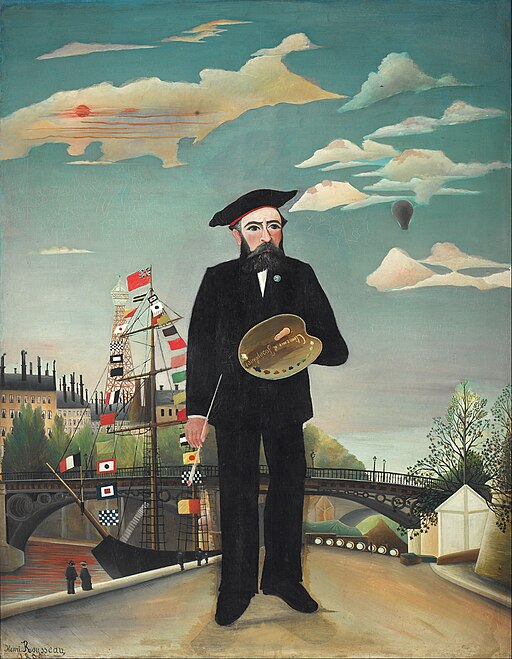
Description: In this self-portrait, Rousseau presents himself not in a studio, but standing proudly in a Parisian park. He’s dressed as a painter, holding a palette and brush, with a ship and the new Eiffel Tower in the background. He looks very serious, presenting himself as a great artist. It’s a bold statement from a man who was often told he wasn’t a ‘real’ painter. The name of his two wives, Clémence and Joséphine, are written on the palette he holds in the painting.
Painting Techniques: The figure of Rousseau is disproportionately large compared to the background, a typical feature of his ‘naïve’ style. He flattens the space but fills it with charming details like the flags on the ship and the clouds in the sky, blending portraiture with landscape painting.
Location: National Gallery Prague, Prague, Czech Republic
Estimated Value: Priceless
The Wedding Party (c. 1905)
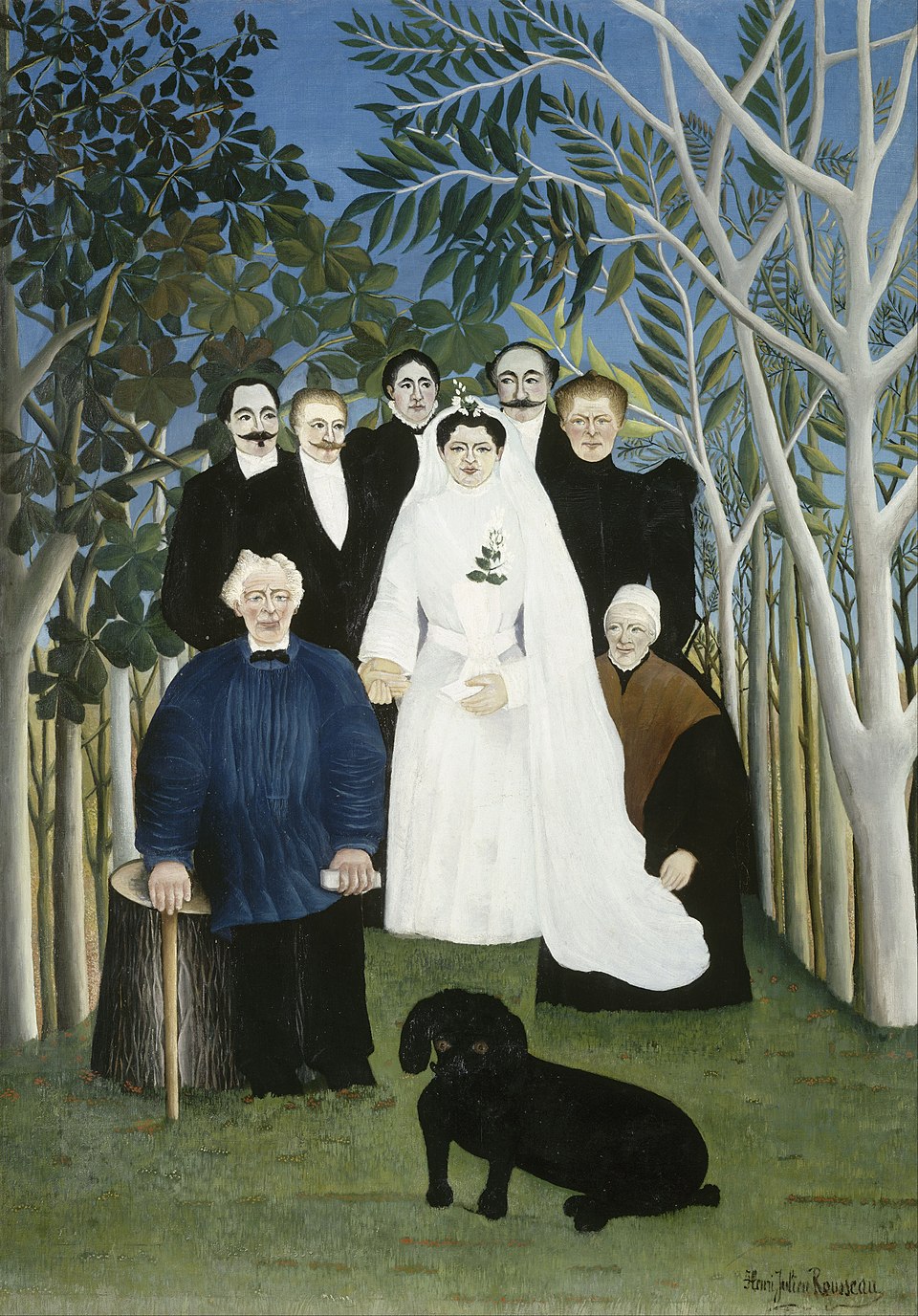
Description: A quirky and charming group portrait shows a wedding party, including the artist himself, posing stiffly for the camera. The bride, looking like a doll, sits in the center. The figures are not realistically proportioned, and the background is a simple, pleasant park. There’s a stiff, formal feeling to the painting, but it’s also full of personality and humor, making it a beloved work. The strange little dog-like creature in the foreground doesn’t appear to be based on any real animal, adding to the painting’s quirky charm.
Painting Techniques: Rousseau’s signature style is evident in the flat application of paint, the awkward but endearing poses of the figures, and the lack of concern for realistic scale. The dark colors of the suits contrast sharply with the bride’s white dress, making her the undeniable center of attention.
Location: Musée de l’Orangerie, Paris, France
Estimated Value: Priceless
Inspiration and Legacy
Henri Rousseau famously claimed to have ‘no teacher other than nature,’ but he was inspired by the world around him in Paris. He loved visiting the Jardin des Plantes (a botanical garden), the natural history museum, and the zoo. He also studied pictures in illustrated magazines and admired the academic style of painters like Jean-Léon Gérôme, though he reinterpreted it in his own untrained way.
His legacy is immense. While initially mocked, he was championed by the next generation of artists. Pablo Picasso famously discovered one of his paintings being sold to be painted over and immediately recognized its genius. Rousseau’s dreamlike imagery and disregard for academic rules directly inspired the Surrealists, like Salvador Dalí and Max Ernst, as well as many other modern artists who admired his pure, unfiltered creativity.
Final Thoughts: Top 10 Henri Rousseau paintings
Henri Rousseau’s journey is a powerful reminder that you don’t need formal training to create something truly magical. He painted from his imagination, creating unforgettable worlds that continue to captivate audiences today. The legacy of Henri Rousseau paintings lies in their honesty, their mystery, and their vibrant celebration of the wildness of dreams. He proved that the most important tool for an artist isn’t a fancy degree, but a unique vision and the courage to share it with the world.
FAQs: Henri Rousseau paintings
Why is Henri Rousseau called ‘Le Douanier’?
He was given the nickname ‘Le Douanier,’ which is French for ‘the customs officer,’ because he worked for many years as a toll and tax collector for the city of Paris before retiring to paint full-time.
Did Henri Rousseau ever actually visit a jungle?
No, he never left France! His incredibly lush and detailed jungle scenes were completely imaginary. He drew inspiration from visits to the botanical gardens and natural history museums in Paris, as well as from illustrations in books and magazines.
What art style is Henri Rousseau known for?
Rousseau is most associated with the Post-Impressionist movement and is considered the most famous example of Naïve or Primitive art. This style is characterized by a lack of formal training, resulting in a charming disregard for rules of perspective, proportion, and color.
Was Henri Rousseau a successful artist in his lifetime?
It’s complicated. Mainstream critics often ridiculed his work, but he was deeply admired by a small circle of cutting-edge artists like Pablo Picasso, Fernand Léger, and Robert Delaunay, who saw him as a genius of modern art.

